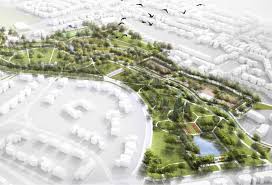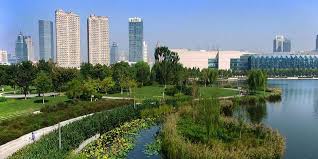Introduction:
As urbanization accelerates and cities grapple with the challenges of climate change, pollution, and dwindling green spaces, the integration of nature-based solutions (NBS) in urban design has emerged as a powerful strategy for creating healthier, more resilient, and sustainable communities. By harnessing the inherent benefits of nature, such as biodiversity, ecosystem services, and natural processes, cities can mitigate environmental degradation, improve quality of life, and foster greater social cohesion. In this blog post, we explore the principles, benefits, and applications of nature-based solutions in urban design, highlighting their transformative potential in shaping the cities of tomorrow.
Understanding Nature-Based Solutions:
Nature-based solutions encompass a diverse array of strategies and interventions that mimic or enhance natural processes to address urban challenges and promote sustainability. These solutions leverage the inherent resilience of ecosystems and biodiversity to provide a wide range of benefits, including climate regulation, flood mitigation, air and water purification, biodiversity conservation, and cultural enrichment. Examples of nature-based solutions include green roofs, urban parks, green infrastructure, rain gardens, permeable pavements, and constructed wetlands, among others.
Key Principles of Nature-Based Urban Design:
1. Biophilic Design: Biophilic design principles emphasize the integration of natural elements, patterns, and materials into the built environment to enhance human well-being and connection with nature. Incorporating elements such as green spaces, natural light, water features, and natural materials can reduce stress, improve mental health, and increase productivity among urban residents.
2. Multifunctionality: Nature-based solutions should serve multiple functions and provide a diverse range of benefits to urban communities. For example, green roofs not only mitigate urban heat island effects and reduce stormwater runoff but also provide habitat for wildlife, improve air quality, and enhance aesthetic appeal.
3. Resilience and Adaptation: Nature-based solutions should be designed to enhance the resilience of urban ecosystems and communities to climate change impacts, such as extreme weather events, flooding, heatwaves, and sea-level rise. Strategies such as coastal wetland restoration, green infrastructure, and urban forestation can help buffer against environmental hazards and enhance adaptive capacity.
4. Community Engagement: Engaging with local communities and stakeholders is essential for the successful implementation of nature-based solutions. Participatory planning processes, citizen science initiatives, and community-led green space projects empower residents to shape their urban environment, foster social cohesion, and build a sense of ownership and stewardship.
5. Collaboration and Integration: Nature-based solutions require interdisciplinary collaboration and integration across sectors, including urban planning, landscape architecture, ecology, engineering, and social sciences. By breaking down silos and fostering cross-sectoral partnerships, cities can leverage diverse expertise and resources to develop holistic, integrated solutions that address complex urban challenges effectively.
Benefits of Nature-Based Solutions in Urban Design:
1. Climate Resilience: Nature-based solutions help cities adapt to climate change impacts by reducing flood risk, enhancing water retention, and mitigating urban heat island effects. Green infrastructure, such as green roofs, bioswales, and urban forests, provides natural cooling, shade, and water infiltration, helping to regulate temperatures and reduce energy consumption.
2. Biodiversity Conservation: Urban green spaces and ecological corridors serve as important habitats for native flora and fauna, supporting biodiversity conservation and ecological connectivity in urban environments. By preserving and restoring natural habitats, cities can enhance ecosystem services, such as pollination, pest control, and soil fertility, which are essential for human well-being and ecosystem health.
3. Improved Air and Water Quality: Vegetation and green infrastructure play a vital role in improving air and water quality in urban areas. Trees and plants absorb pollutants, such as carbon dioxide, nitrogen oxides, and particulate matter, and release oxygen, helping to purify the air and mitigate air pollution-related health risks. Similarly, green infrastructure features, such as rain gardens and constructed wetlands, filter pollutants from stormwater runoff, improve water quality, and recharge groundwater aquifers.
4. Social and Health Benefits: Access to green spaces and nature-rich environments has been linked to numerous physical, mental, and social health benefits. Urban green spaces provide opportunities for recreation, exercise, relaxation, and social interaction, reducing stress, anxiety, and depression among urban residents. Additionally, nature-based solutions promote social equity and environmental justice by ensuring equitable access to green spaces and ecosystem services for all members of society, regardless of socioeconomic status or geographic location.
5. Economic Value: Nature-based solutions offer substantial economic benefits to cities by reducing infrastructure costs, lowering healthcare expenditures, increasing property values, and stimulating economic activity. Green infrastructure investments, such as urban parks, green roofs, and tree canopy expansion, generate jobs, attract tourists, and enhance the attractiveness and competitiveness of cities as desirable places to live, work, and invest.
Applications of Nature-Based Solutions in Urban Design:
1. Green Infrastructure: Incorporating green infrastructure features, such as vegetated swales, rain gardens, permeable pavements, and green roofs, helps manage stormwater runoff, reduce flooding, and enhance urban biodiversity.
2. Urban Parks and Green Spaces: Creating and preserving urban parks, greenways, and natural reserves provides opportunities for recreation, relaxation, and biodiversity conservation, while improving air quality and mitigating urban heat island effects.
3. Sustainable Urban Forests: Planting and maintaining urban forests and street trees enhance biodiversity, sequester carbon, reduce air pollution, and provide shade and cooling in densely built urban areas.
4. Blue-Green Infrastructure: Integrating blue-green infrastructure, such as constructed wetlands, bioswales, and coastal ecosystems, helps manage water resources, improve water quality, and enhance climate resilience in coastal and waterfront cities.
5. Green Roofs and Living Walls: Installing green roofs and living walls on buildings helps reduce energy consumption, mitigate heat island effects, improve air quality, and enhance urban aesthetics, while providing habitat for wildlife and promoting biodiversity.
Challenges and Considerations:
Despite their numerous benefits, the widespread adoption of nature-based solutions in urban design faces several challenges:
1. Limited Awareness and Capacity: Many urban planners, policymakers, and developers may lack awareness of the benefits and potential of nature-based solutions or may lack the technical expertise and capacity to implement them effectively.
2. Land Use and Space Constraints: Urban areas often face competing demands for land use, limited space, and development pressures, making it challenging to allocate sufficient green space and natural areas for nature-based solutions.
3. Funding and Financing: Securing funding and financing for nature-based solutions projects can be challenging, particularly for cash-strapped municipalities and local governments with competing budget priorities.
4. Regulatory and Institutional Barriers: Regulatory frameworks, zoning ordinances, and building codes may pose barriers to the implementation of nature-based solutions, requiring regulatory reforms and institutional coordination to facilitate their integration into urban planning and development processes.
5. Maintenance and Long-Term Management: Nature-based solutions require ongoing maintenance and management to ensure their effectiveness and longevity. Adequate resources, training, and community engagement are essential to sustainably manage green infrastructure and urban green spaces over time
Conclusion:






